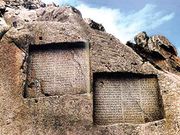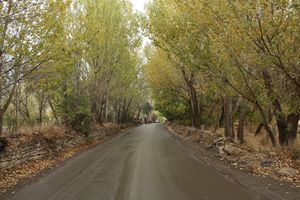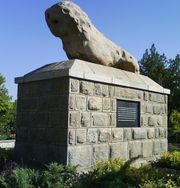همدان
همدان
همدان Hamadan | |
|---|---|
city | |
| Ancient names: Ecbatana، Hangmatana | |
همدان في إيران | |
| الإحداثيات: 34°48′N 48°31′E / 34.800°N 48.517°E | |
| اليلد | |
| المحافظة | همدان |
| المقاطعة | همدان |
| بخش | المركزي |
| المنسوب | 1٬850 m (6٬069 ft) |
| التعداد (2006) | |
| • الإجمالي | 473٬149 |
| • الترتيب | 14th in Iran |
| منطقة التوقيت | UTC+3:30 (IRST) |
| • الصيف (التوقيت الصيفي) | UTC+4:30 (IRDT) |
| الموقع الإلكتروني | www |
همدان[1] (Hamadān ؛ pronounced [Hæmædɒːn] (![]() استمع)) أو Hamedān (فارسية: همدان, Hamadān) (الفارسية القديمة: Haŋgmetana, Ecbatana) هي المدينة عاصمة محافظة همدان في غرب إيران. وفي تعداد 2006، بلغ عدد سكانها 473,149، في 127,812 عائلة.[2]
استمع)) أو Hamedān (فارسية: همدان, Hamadān) (الفارسية القديمة: Haŋgmetana, Ecbatana) هي المدينة عاصمة محافظة همدان في غرب إيران. وفي تعداد 2006، بلغ عدد سكانها 473,149، في 127,812 عائلة.[2]
Hamadan is believed to be among the oldest Iranian cities and one of the oldest in the world. It is possible that it was occupied by the Assyrians in 1100 BCE; the Ancient Greek historian, Herodotus، states that it was the capital of the Medes، حوالي 700 ق.م..
Hamadan has a green mountainous area in the foothills of the 3,574-meter Alvand Mountain, in the midwest part of Iran. The city is 1,850 meters above sea level.
The special nature of this old city and its historic sites attract tourists during the summer to this city, located approximately 360 kilometres (220 miles) southwest of Tehran.
The main symbols of this city are the Ganj Nameh inscription, the Avicenna monument and the Baba Taher monument. The majority of the population is Persian;[3][4][5]
التاريخ


According to Clifford Edmund Bosworth، "Hamadan is a very old city. It may conceivably, but improbably, be mentioned in cuneiform texts from ca. 1100 BC, the time of Assyrian King Tiglath-pilesar I, but is certainly mentioned by Herodotus (i.98) who says that the king of Media Diokes built the city of Agbatana or Ekbatana in the 7th century BC."[6]
Hamadan was established by the Medes and was the capital of the Median Empire. It then became one of several capital cities of the Achaemenid Dynasty.
Hamadan is mentioned in the biblical book of Ezra as the place where a scroll was found giving the Jews permission from King Darius to rebuild the temple in Jerusalem. (Ezra 6:2). Its ancient name of Ecbatana is used in the Ezra text. Because it was a mile above sea level, it was a good place to preserve leather documents.
During the Parthian era, Ctesiphon was the capital of the country, and Hamadan the summer capital and residence of the Parthian rulers. After the Parthians, the Sassanids constructed their summer palaces in Hamadan. In the year 633 the battle of Nahavand took place and Hamadan fell into the hands of the Muslim Arabs.
During the Buwayhids، the city suffered much damage. In the 11th century, the Seljuks shifted their capital from Baghdad to Hamadan. The city of Hamadan, its fortunes following the rise and fall of regional powers, was completely destroyed during the Timurid invasion. During the Safavid era, the city thrived. Thereafter, in the 18th century, Hamadan was surrendered to the Ottomans، but due to the work of Nader Shah e Afshar، Hamadan was cleared of invaders and, as a result of a peace treaty between Iran and the Ottomans, it was returned to Iran. Hamadan stands on the Silk Road، and even in recent centuries the city enjoyed strong commerce and trade as a result of its location on the main road network in the western region of Persia and Iran.
During الحرب العالمية الأولى، the city was the scene of heavy fighting between Russian and Turko-German forces. It was occupied by both armies, and finally by the British, before it was returned to control of the Iranian government at the end of the war in 1918.
الطقس
Hamadan province lies in a temperate mountainous region to the east of Zagros. The vast plains of the north and northeast of the province are influenced by strong winds, that almost last throughout the year.
The various air currents of this region are: the north and north west winds of the spring and winter seasons, which are usually humid and bring rainfall. The west-east air currents that blow in the autumn, and the local winds that develop due to difference in air-pressure between the elevated areas and the plains, like the blind wind of the Asad Abad region.
| أخفClimate data for همدان | |||||||||||||
|---|---|---|---|---|---|---|---|---|---|---|---|---|---|
| Month | Jan | Feb | Mar | Apr | May | Jun | Jul | Aug | Sep | Oct | Nov | Dec | Year |
| Record high °C (°F) | 17.0 (62.6) |
19.0 (66.2) |
25.0 (77.0) |
28.0 (82.4) |
33.0 (91.4) |
39.0 (102.2) |
40.6 (105.1) |
39.4 (102.9) |
36.4 (97.5) |
30.0 (86.0) |
23.0 (73.4) |
18.8 (65.8) |
40.6 (105.1) |
| Mean daily maximum °C (°F) | 2.0 (35.6) |
4.3 (39.7) |
11.5 (52.7) |
18.1 (64.6) |
23.9 (75.0) |
30.9 (87.6) |
34.9 (94.8) |
34.2 (93.6) |
29.8 (85.6) |
21.9 (71.4) |
13.7 (56.7) |
5.9 (42.6) |
19.3 (66.7) |
| Daily mean °C (°F) | −4.6 (23.7) |
−2.2 (28.0) |
4.5 (40.1) |
10.4 (50.7) |
15.5 (59.9) |
21.3 (70.3) |
25.3 (77.5) |
24.3 (75.7) |
19.0 (66.2) |
12.1 (53.8) |
5.3 (41.5) |
−0.9 (30.4) |
10.8 (51.5) |
| Mean daily minimum °C (°F) | −10.5 (13.1) |
−8.2 (17.2) |
−2.1 (28.2) |
2.7 (36.9) |
6.4 (43.5) |
9.8 (49.6) |
13.9 (57.0) |
12.8 (55.0) |
7.0 (44.6) |
2.5 (36.5) |
−2.1 (28.2) |
−6.6 (20.1) |
2.1 (35.8) |
| Record low °C (°F) | −34 (−29) |
−33.0 (−27.4) |
−21 (−6) |
−12.0 (10.4) |
−3.0 (26.6) |
2.0 (35.6) |
7.0 (44.6) |
4.0 (39.2) |
−4.0 (24.8) |
−7.0 (19.4) |
−14.5 (5.9) |
−29 (−20) |
−34 (−29) |
| Average precipitation mm (inches) | 46.3 (1.82) |
43.6 (1.72) |
49.4 (1.94) |
49.8 (1.96) |
37.8 (1.49) |
3.7 (0.15) |
2.0 (0.08) |
1.8 (0.07) |
0.8 (0.03) |
20.7 (0.81) |
26.9 (1.06) |
40.9 (1.61) |
323.7 (12.74) |
| Average rainy days | 11.6 | 11.1 | 12.4 | 12.1 | 9.5 | 2.0 | 1.3 | 1.6 | 1.0 | 5.6 | 6.8 | 10.1 | 85.1 |
| Average snowy days | 8.8 | 8.2 | 4.2 | 0.6 | 0 | 0 | 0 | 0 | 0 | 0.2 | 0.9 | 6.9 | 29.8 |
| Average relative humidity (%) | 76 | 73 | 64 | 56 | 50 | 36 | 31 | 31 | 34 | 48 | 61 | 73 | 53 |
| Mean monthly sunshine hours | 131.8 | 137.1 | 174.5 | 199.6 | 258.5 | 341.8 | 342.7 | 322.2 | 295.6 | 234.3 | 183.1 | 135.3 | 2٬756٫5 |
| Source: NOAA (1961-1990)[7] | |||||||||||||
Hamadan is in the vicinity of the Alvand mountains and has a dry summer continental climate (Köppen climate classification Dsa), in transition with a cold semi-arid climate (Köppen climate classification BSk), with snowy winters. In fact, it is one of the coldest cities in Iran. The temperature may drop below −30 °C (−22 °F) on the coldest days. Heavy snowfall is common during winter and this can persist for periods of up to two months. During the short summer, the weather is mild, pleasant, and mostly sunny.
 Alvand Mountain |
منظر پانورامي
الناس
According to the survey of 1997, the population of the province of Hamadan was 1,677,957.[8] Based on official statistics of 1997, the population of Hamadan county was 563,444 people. The majority of population are Persians with a sizeable minority of Azeris,[9] and a small group of Jews.[10]
الثقافة
Hamadan is home to many poets and cultural celebrities. The city is also said to be among the world's oldest continuously inhabited cities.
Hamadan has always been well known for handicrafts like leather, ceramic, and carpets.
Iran's Cultural Heritage Organization lists 207 sites of historical and cultural significance in the city of Hamadan alone.
A tomb believed by some to hold the remains of tomb the biblical Esther and her cousin Mordechai is located in Hamadan.
The scientist and writer known in the west as Avicenna (Abu Ali Sina) is buried in Hamadan. The 11th-century Iranian poet Baba Taher is also interred in Hamadan.
This city is also the birthplace of Badi' al-Zaman al-Hamadani، author of the Maqamat.
معرض
Tomb of Baba Taher
The Tomb of Avicenna
The handwriting of Canon of Medicine in the Tomb of Avicenna
Tomb of Esther and Mordechai، a tomb believed by some to hold the remains of Esther and Mordechai
الرياضة
PAS Hamedan F.C. were founded on June 9, 2007 after the dissolution of PAS Tehran F.C.. The team, along with Alvand Hamedan F.C.، currently participates in the Azadegan League.
Some sport complexes in this city include: Qods Stadium، Shahid Mofatteh Stadium، Takhti Sport Complex and the National Stadium of Hamadan.
التعليم
Before the Persian Constitutional Revolution، education in Hamadan was limited to some Maktab Houses and theological schools. Fakhrie Mozafari School was the first modern school of Hamadan, which was built after that revolution. Alliance and Lazarist were also the first modern schools founded by foreign institutions in Hamadan.
Some of the popular universities in Hamadan include:
- Bu-Ali Sina University
- Hamadan Medical University
- Islamic Azad University of Hamadan
- Hamadan University of Technology
مشاهير همدان

- Mir Sayyid Ali Hamadani، poet and scholar
- Abolhassan Banisadr، economist, politician, and the first post-revolutionary elected president of the Islamic Republic of Iran
- Amir Nosrat'ollah Balakhanlou، born in Tehran — two-time mayor and MP for Hamadan City (1950s and early 1960s)
- Amir-Shahab Razavian، film director, writer and producer
- Baba-Taher-e Oryan، a famous Poet (1100 A.c)
- Ein-Alqozat Hamadani، a great philosopher and sufist (1100 A.C)
- Ehsan Yarshater، historian, scientists, and founder of Encyclopædia Iranica
- Fakhr-al-Din Iraqi، celebrated poet (1300 A.C)
- [11] Farid al-Dawla Golgoon, Farid-al-Dawla was a trusted political figure in Hamadān, a constitutionalist and a journalist, Mayor.
- Fazlollah Zahedi، military general
- Fereydoun Moshiri، contemporary poet (originally from Hamadan, but born in Tehran)
- Hanieh Tavassoli، actress
- Joseph Emin، a major activist in the attempts to liberate Armenia during the 18th century
- Mirzadeh Eshghi، a celebrated nationalist poet
- Parviz Parastouei، acclaimed actor
- Rashid-al-Din Hamadani، Persian statesman, historian and physician of the 13th-14th centuries
- Shirin Ebadi، lawyer and the 2003 Nobel Peace Laureate
- Samuel Rahbar، scientist
- Viguen، known as the king of Persian pop and jazz music
العلاقات الدولية
بلدات توأم – مدن شقيقة
Hamadan is twinned with:
انظر أيضاً
الهامش
- ^ Multiple Authors (April 18, 2012). "HAMADĀN". Encyclopædia Iranica. Retrieved 18 April 2015.
- ^ "تعداد جمهورية إيران الإسلامية 1385 (2006)". جمهورية إيران الإسلامية. Archived from the original (Excel) on 2011-11-11.
{{cite web}}:|archive-date=/|archive-url=timestamp mismatch; 2011-09-20 suggested (help) - ^ Introduction: Hamedan Province
- ^ Mohammad Jalal Abbasi-Shavazi, Peter McDonald, Meimanat Hosseini-Chavoshi, "The Fertility Transition in Iran: Revolution and Reproduction", Springer, 2009. pp 100-101: "The first category is 'Central' where the majority of people are Persian speaking ethnic Fars (provinces of Fars, Hamedan, Isfahan, Markazi, Qazvin, Qom, Semnan, Yazd and Tehran..."
- ^ (Parviz Aḏkāʾi and EIr, HAMADĀN i. GEOGRAPHY in Encyclopædia Iranica:"Languages spoken. Hamadān has been a crossroads of civilizations for millennia and a mosaic of cultures and dialects live there side by side. The main language spoken, especially in the provincial capital and its surroundings, is Persian, which is also the lingua franca in other regions. In the northern parts of the province, however, the language mostly spoken is Azeri Turkish, while in the northwest and west, near the provinces of Kurdistan and Kermānšāhān, people mostly speak Kurdish, while in some other cities such as Malāyer, Nehāvand, and Sāmen most people speak Lori and Lak (Faraji, p. 1296)."
- ^ Bosworth, Clifford Edmund (2008). Historic Cities of the Islamic World. Brill Academic Publishers. p. 151. ISBN 978-90-04-15388-2.
- ^ "Hamedan Nozheh Climate Normals 1961-1990". National Oceanic and Atmospheric Administration. Retrieved December 28, 2012.
- ^ Official statistics from 1997 (1375) - Hamadan provinces - Population and ethnicites - Archive copy at the Internet Archive accessed on March 12, 2006. Replaced with Archive link on Feb 22, 2010.
- ^ Hamadan (Iran) - Encyclopædia Britannica
- ^ Hamadan - LookLex Encyclopaedia
- ^ http://www.iranicaonline.org/articles/golgun
- ^ در ششمین همایش بوعلی سینا در بخارا؛ «بخارا» زادگاه و «همدان» مدفن بوعلیسینا خواهرخوانده میشوند
وصلات خارجية
- Hamadan Medical University
- Ecbatana, Photos from Iran, Livius.
- Gandj Nameh, Photos from Iran, Livius.
- The Bisotun inscription, Photos from Iran, Livius.
- Photos from Hamadan City
- Hamadan City
- Hamadan: Older than history
- Hamadan; Capital of Median Empire
- Iconos satellite photo (January, 2005)
- Google Satellite Picture
- Hamedan Cultural Heritage Organization (فارسي)
- Hegmataneh Official Website
- Hamadān entries in the
| سبقه - |
Capital of Median Empire As "Ecbatana" 678–549 BCE |
تبعه - |
| سبقه - |
Capital of Achaemenid Empire (Persia) As "Ecbatana" Served as Summer Capital 550–330 BCE |
تبعه - |
| سبقه Isfahan |
Capital of Seljuq Empire (Persia) (Western capital) 1118–1194 |
تبعه - |
| سبقه Isfahan |
Capital of Iran (Persia) 1118–1194 |
تبعه Gurganj |
خطأ لوا في وحدة:Authority_control على السطر 278: attempt to call field '_showMessage' (a nil value).
- Pages using gadget WikiMiniAtlas
- CS1 errors: archive-url
- Articles with hatnote templates targeting a nonexistent page
- Missing redirects
- Short description is different from Wikidata
- Articles containing فارسية-language text
- Coordinates on Wikidata
- Pages using infobox settlement with unknown parameters
- Populated places in Hamadan County
- Cities in Hamadan Province
- عواصم محافظات إيرانية
- الأسر البابلي
- أماكن مأهولة على طريق الحرير
- همدان






















